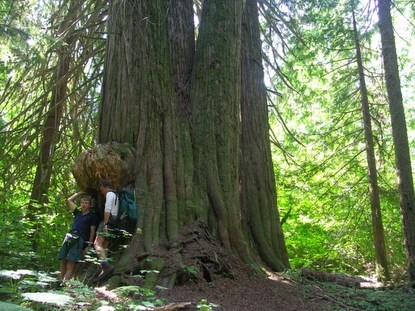
M Kirshenbaum June 8th, 2023 The Big Beaver Trail is a premier old-growth forested hike, with plenty to admire along its route. It's low elevation makes it an excellent early- or late-season hike. It offers a pleasant day hike from Ross Lake or a backpack of one to four days among groves of old growth cedar trees, clear, sparkling streams, and lush undergrowth with woodland flowers. The valley is excellent habitat for beavers and therefore mosquitos, so come prepared. The Big Beaver trail joins the Little Beaver Trail about a mile downstream of Stillwell camp, and from here it is possible to continue on the Little Beaver Trail for 10 more miles (16 km) to Ross Lake, or head upstream 6 miles (10 km) to Whatcom Pass. See the detailed trail description for more information on this area. Special Concerns:
Backcountry Camping: A backcountry permit is required for all overnight stays. Permits are limited. There are numerous campsites along this trail, at most five miles apart. Stock must stay in designated stock sites at Big Beaver, 39 Mile, or Beaver Pass. Access: Most hikers start at the Ross Dam Trail, which begins at a parking area near milepost 134 on State Route 20. The trail drops steeply for .8 miles (1.3 km) to a gravel service road. Go left on this road for a short way, then turn right down an incline to the top of Ross Dam. Cross the dam and continue north along the west shore of Ross Lake. Ross Lake Resort also provides water taxi service to either Big Beaver or Little Beaver landings (thus allowing for a loop hike connecting to the Little Beaver Trail). Detailed Trail Description From Ross Dam, it is 6 miles (10 km) of easy walking along Ross Lake to Big Beaver Creek. Look for evidence of a 1926 forest fire that burned a large area in the upper Skagit Valley and across Sourdough Mountain. The trail crosses several small creeks and offers glimpses of the lake through stands of lodgepole pine and Douglas-fir. Enjoy the special place where Pierce Creek cascades from its chasm, under the footbridge, to Ross Lake. Cross Big Beaver Creek on the steel bridge. Here a short spur trail leads east to Big Beaver stock and boat camps. The trail up Big Beaver is a "tunnel of green," a rich spectrum of forest and water communities. About three miles (5 km) above the bridge hikers enter one of the finest stands of ancient redcedar trees to be found anywhere. Some trees are over 15 feet in diameter and 1,000 years old. The trail skirts acres of active beaver ponds and marshy areas teeming with plant and animal life. Watch and wait, patience may be rewarded with sightings or sounds of beaver, otter, ducks, black bear, or deer. Careful observations will reveal marsh birds, Common Yellowthroat, Barrow's Goldeneye and possibly tree nesting ducks like Common Merganser and Wood Duck. In 1991 the rare, unspoiled Big Beaver marsh land was designated a Research Natural Area-a place to observe and learn from ongoing natural processes. Seven miles (11 km) above Ross Lake one can look up the gorge of McMillan Creek toward McMillan Cirque and McMillan Spires. These places were named for mountain man John McMillan, who came here in 1884. John homesteaded in this beautiful, lonesome Big Beaver valley where he brought his bride, Emma, to join in a life of subsistence (trapping, prospecting, packing) and adventure. Emma and friends buried John beside Big Beaver Creek in 1922. Thirteen miles (21 km) from Ross Lake, hikers arrive at the broad, forested saddle of Beaver Pass. From here, it is 2.9 miles (4.7 km) and a series of steep switchbacks to Stillwell Camp, on Little Beaver Creek. The bridge over the creek and the junction with the Little Beaver Trail are approximately one mile (1.6 km) downstream from Stillwell. Complete the semi-loop hike to Little Beaver in another 10 miles (16 km), but only if you have a boat ride waiting at Little Beaver landing-there are no connecting trails from Little Beaver landing. 
NPS/Kirshenbaum 
|
Last updated: June 8, 2023
